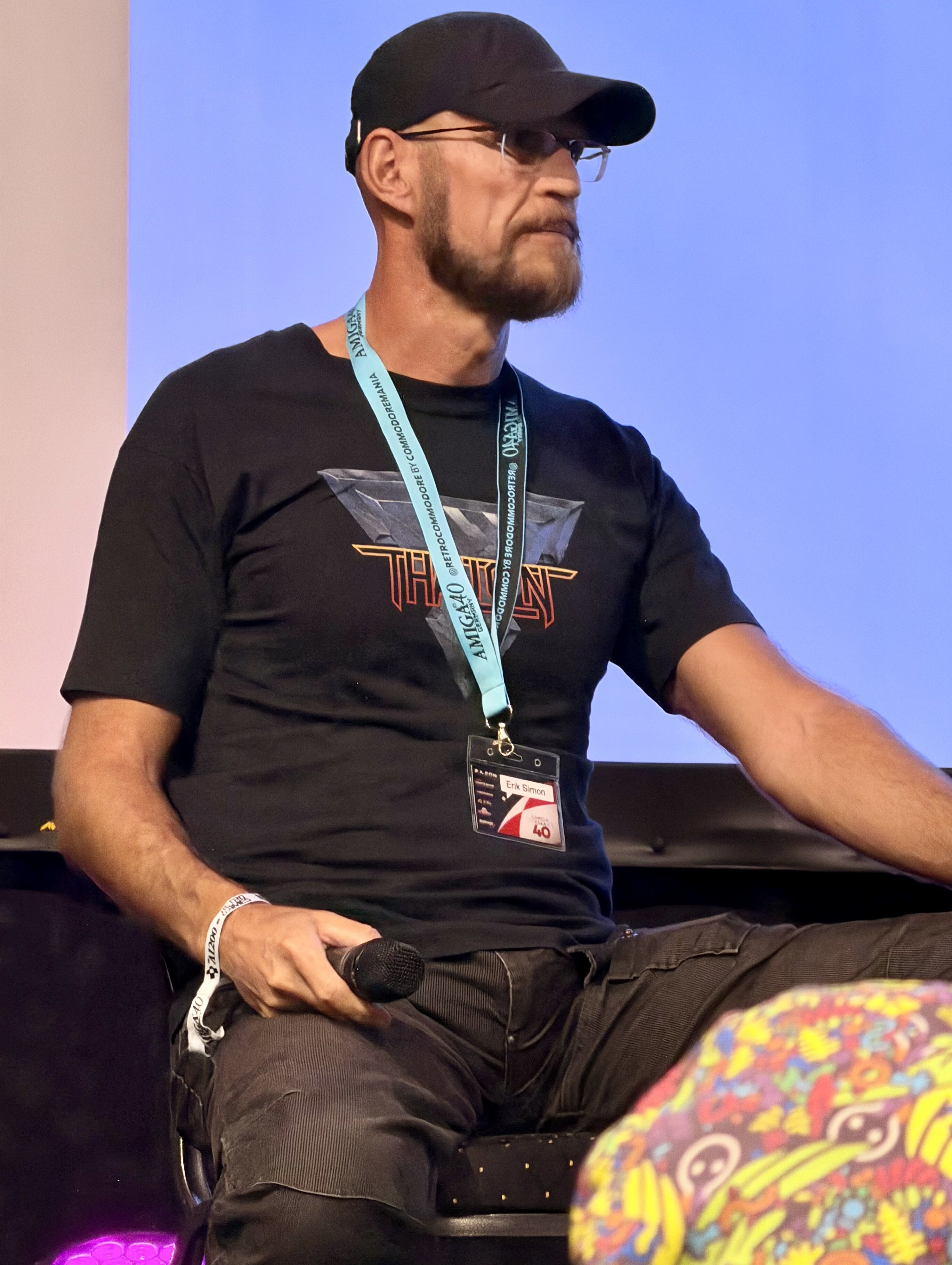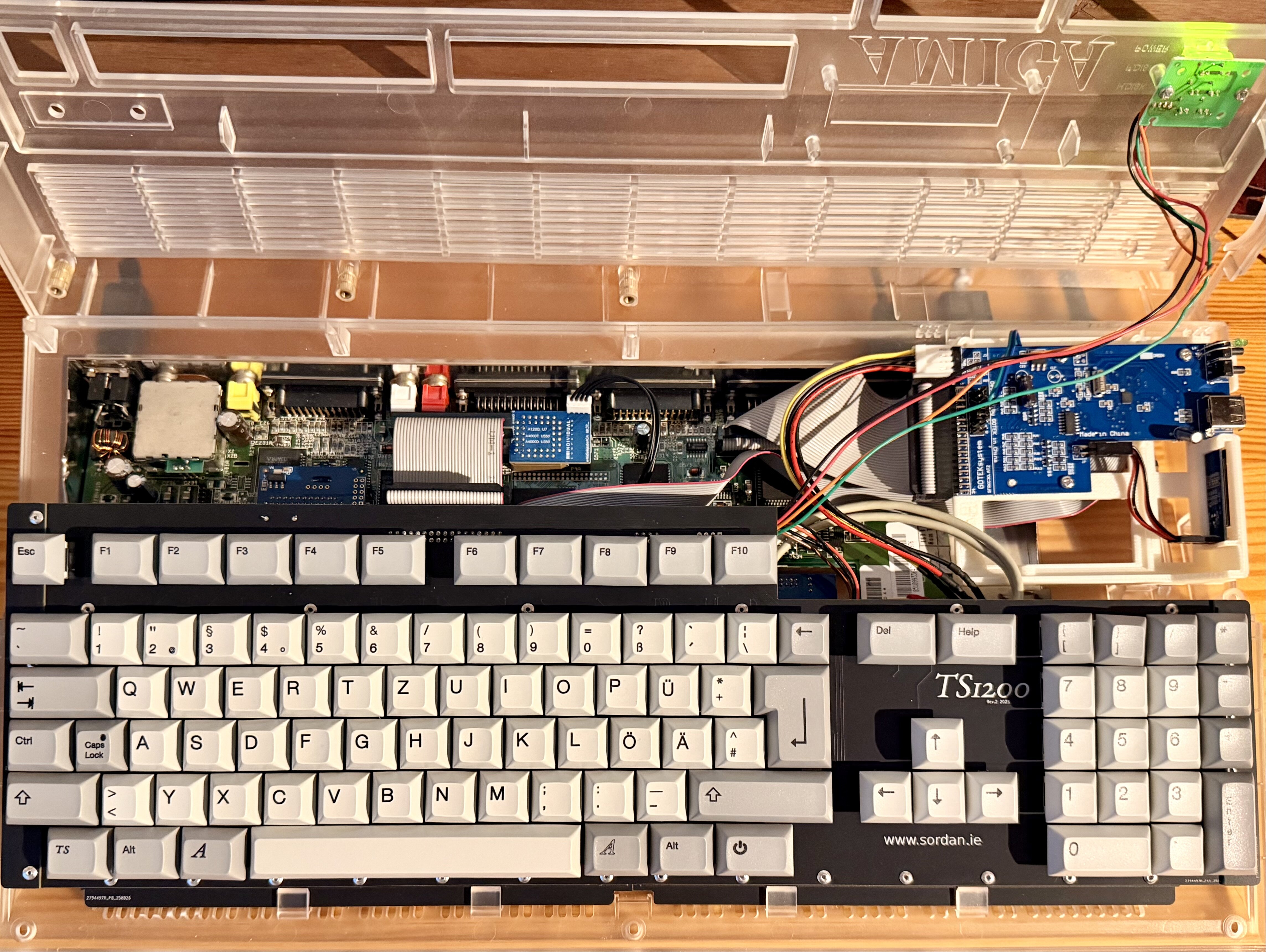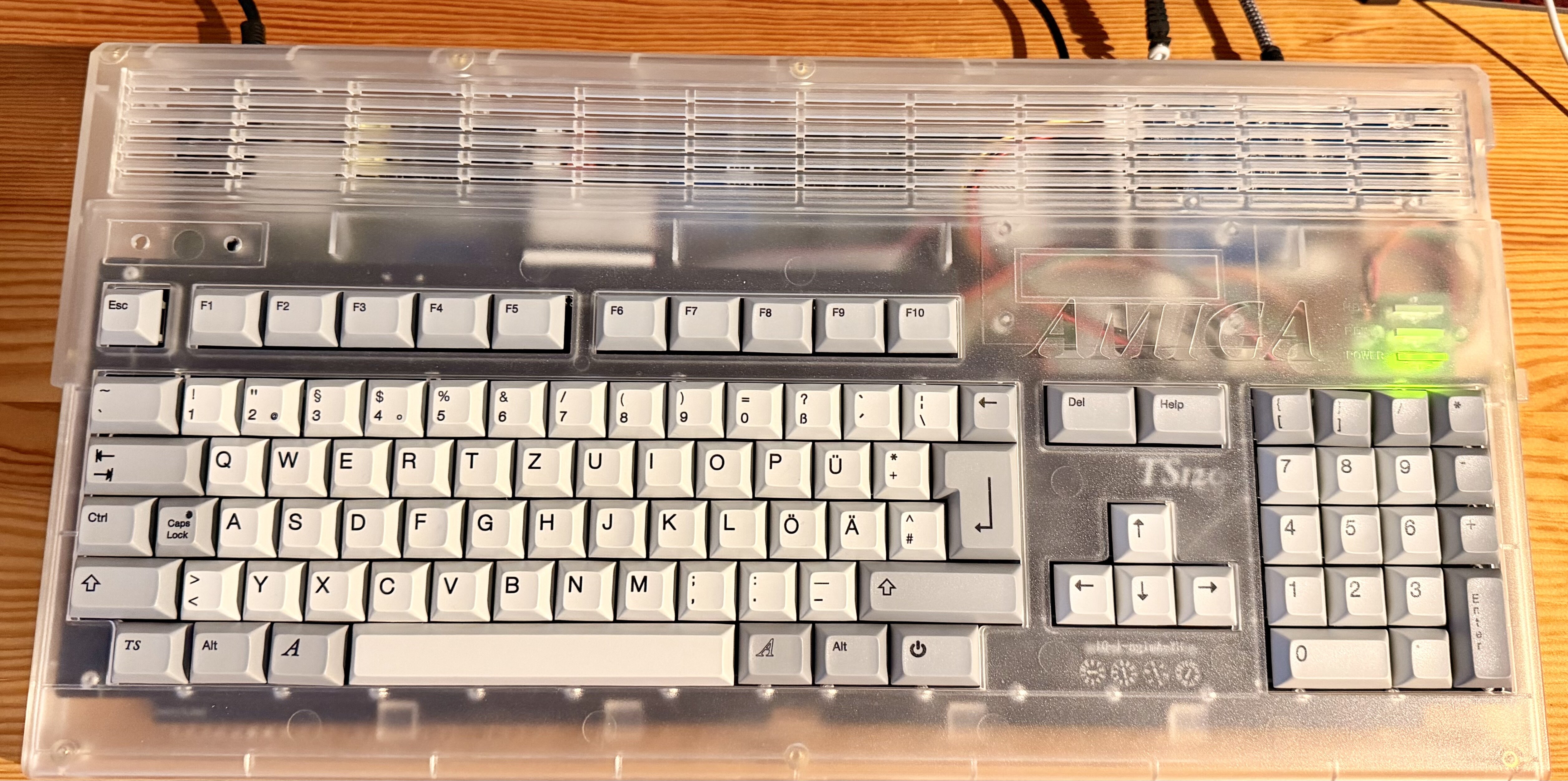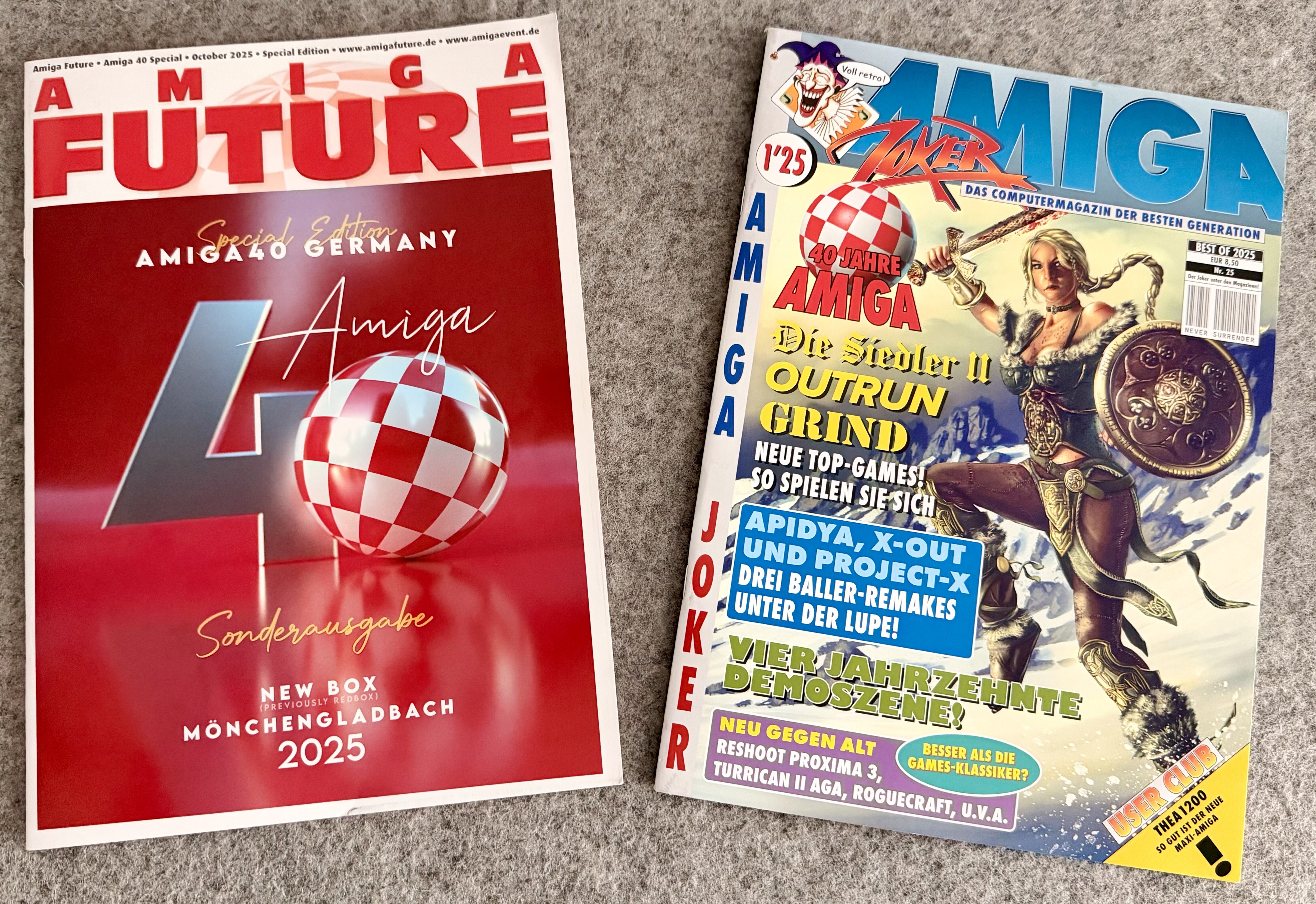Amiga 40 and a new keyboard
19 Oct 2025Yesterday’s visit to the Amiga 40 event in Mönchengladbach proved once again that the Amiga community is alive and well. The atmosphere at this 40th anniversary celebration was electric, reminiscent of the Amiga fairs in Cologne in the early 1990s, when the platform was at its peak.
A Living, Breathing Community
What struck me most profoundly was the community’s vitality. The event attracted enthusiasts from across Europe and beyond, fostering an atmosphere in which animated conversations about Motorola 68K processors and the Amiga’s custom chipsets were the norm. This was not just nostalgia; it was an active community that is still pushing the boundaries of what these machines can do.
The organisers had clearly learned from previous events. With over 1,100 attendees per day at the NEW Box venue, the space felt intimate enough for meaningful conversations yet expansive enough to accommodate an impressive array of hardware demonstrations and vendor displays.
Erik Simon and Thalion
Out of all the presentations of the stage programme, I only attended the interview with Erik Simon. Hearing him recount what development at Thalion was like back in the day was fascinating, offering a glimpse into the creative process behind some of the Amiga’s most ambitious titles. I have particularly fond memories of playing Amberstar and Ambermoon, two games whose depth and world-building captured my imagination. Lionheart was undoubtedly a technological masterpiece that pushed the boundaries of what the Amiga could achieve, but unfortunately it was not my type of game. Nevertheless, hearing Simon’s stories made me appreciate the innovation and dedication that went into every Thalion release.

Technical Conversations
One of the highlights of the event was my in-depth conversation with Jens Schönfeld from Individual Computers. His insights into the development of the ACA 1260 processor board were particularly illuminating. The board represents a significant leap forward in Amiga acceleration technology, featuring revolutionary chip RAM write performance that achieves zero-wait-state speeds — a feat that evaded the ‘turbo cards’ of the 1990s.
The ACA 1260’s technical specifications are equally impressive, including 256 MB of physical memory, software-adjustable CPU core voltage for overclocking and underclocking, and an innovative cooling system with temperature sensors and fan speed control. Perhaps most intriguingly of all, the board includes provisions for future mass storage support via a micro-SD card slot, though this feature is still in development.
What resonates most about Individual Computers’ approach is their commitment to compatibility and reliability. The ACA 1260 maintains PCMCIA functionality and features sophisticated power management that primarily draws from the 12V rail. This reduces stress on the often problematic 5V supply in ageing Amiga 1200 systems.
The Eternal Wait for Amiga Reloaded
Inevitably, our discussion turned to the Amiga Reloaded project: Individual Computers’ ambitious plan to create a new, Amiga 1200-compatible motherboard using original AGA chipsets. Although the project is ongoing, it is developing incrementally, with each component being refined and tested in other products before being integrated into the final design.
The Amiga Reloaded is more than just a replacement motherboard: it embodies the community’s desire for a platform that combines authenticity with modern convenience. With planned features including HDMI output and RTG capabilities, it promises to be the ultimate realisation of the Amiga’s potential.
However, such projects inevitably require extensive development time. Jens’s meticulous approach ensures quality, but this necessarily extends timelines. For now, we must continue to wait, sustained by the promise of what could be.
The 68060 Availability Question
One issue that is a major concern for the community, or at least for me, is the long-term availability of 68060 processors. Originally manufactured by Motorola in the mid-1990s, these chips are becoming increasingly scarce. The remaining stock consists primarily of old stock that has been sitting in warehouses for decades, and there are no plans for new production.
Those of us with original Amiga 1200 systems face a dilemma: should we invest in acceleration hardware now, while 68060 chips are still available, or wait for projects like the ACA 1260 to develop further? The opportunity to acquire these processors may not be open indefinitely.
The TS1200 Mechanical Keyboard
One of the items I purchased at the event was the TS1200 mechanical keyboard from Sordan. It features white-grey keycaps and blue tactile switches. These switches provide exactly what I was looking for: a clear tactile bump and a satisfying audible click, which make typing a genuinely enjoyable experience. The dye-sublimation printed keycaps promise longevity, and the plug-and-play compatibility means there are no driver complications — it simply works.
Installing it this morning confirmed my expectations: it fits perfectly in my Amiga 1200’s case, the tactile feedback is excellent and it feels solidly built. Most importantly, it transforms the typing experience from merely functional to genuinely enjoyable.
Here is a photo of the TS1200 installed in my Amiga 1200 with its case open:

And here is a photo of the TS1200 installed in my Amiga 1200 with its case closed:

The Broader Significance
The Amiga 40 event is about more than just bringing enthusiasts together; it shows that the platform is still evolving and refusing to become irrelevant. Although the Amiga will probably never compete in the mainstream computing market again, it has found new life as a platform for creativity, technical challenges and community connections.
The presence of multiple hardware vendors, active development projects and hundreds of enthusiastic participants proves that the Amiga community has successfully transitioned from a commercial entity into a sustainable hobby ecosystem. Projects such as the ACA 1260, mechanical keyboard alternatives and the forthcoming Amiga Reloaded will ensure that these machines continue to serve their communities for years to come.
Amiga Joker and Amiga Future
When I was a teenager in the 1990s, the German magazine Amiga Joker was my main source of information about new Amiga games. Although it was cancelled in 1996 when the Amiga became irrelevant to the mainstream market, new issues are still produced for events such as Amiga 40, providing a wonderful nostalgia trip for those of us who grew up with it. Amiga Future is a German magazine about the Amiga that has been published since 2000, keeping the platform’s community alive and informed. A special Germany Special Edition issue of Amiga Future was given to every attendee of the Amiga 40 event for free: a thoughtful gesture that connected the platform’s storied past with its passionate present-day community.

Looking Forward
As I type this on my newly upgraded A1200, the satisfying click of the mechanical switches serves as a tangible reminder of yesterday’s experience. The Amiga community has evolved beyond the desperate hope for a commercial revival that characterised the late 1990s and early 2000s. Instead, it has embraced its role as a passionate community of hobbyists dedicated to preserving, enhancing, and celebrating these remarkable machines.
At Amiga 40, the conversations were not about regaining relevance; they were about making purposeful progress. From Individual Computers’ methodical approach to hardware development and the community’s embrace of modern conveniences, such as mechanical keyboards, to the simple joy of seeing hundreds of people gathered to celebrate a shared passion, the message is clear: the Amiga community is thriving.
With events like Amiga 40 proving that enthusiasm remains high, and companies like Individual Computers continuing to push technical boundaries, the future looks promising. While we are still waiting for the Amiga Reloaded motherboard, the journey itself has proven to be as rewarding as the destination.
